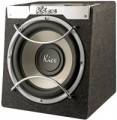Enclosure type
—
Closed box. The simplest type of case: a box closed on all sides with a speaker (speakers) on the front panel. The advantages of such models are high accuracy of sound transmission and low cost, the disadvantages are low sensitivity and somewhat “flat” bass.
—
Phase inverter. A classic phase inverter is a hollow tube connecting the internal volume of the case with the outside world (however, there are other options for such a connection). The length of the phase inverter channel is chosen so that the sound waves of a certain range, passing through it, are inverted in phase relative to the waves from the speaker (hence the name). This improves (in particular, "deepens") the sound of the subwoofer and allows you to achieve good performance with a small cabinet size. On the other hand, the sound stream in the tube creates a certain additional noise.
—
Strip. A design that combines the features of a closed box and a bass-reflex enclosure. One of its parts is made closed, and the second is equipped with a phase inverter tube; between them is a partition, on which the main speaker is located. Unlike previous types, the speaker is entirely inside the case. Strip-line enclosures provide louder sound than boxes or bass reflexes, with sound quality comparable to the latter. The disadvantage is the complexity of the design, as a result — a slightly higher price.
Rated power
The average (root mean square — RMS) power of the input signal, at which the subwoofer is able to work continuously without negative consequences (damage, failure) for at least an hour. The rated power of the subwoofer must be greater than the power of the amplifier connected to it — in order to avoid overloads.
Max. power
The maximum signal power that the subwoofer is able to withstand for a short time (up to several seconds) without any negative consequences. When selecting an amplifier-subwoofer pair, it is recommended to take a subwoofer with a maximum power of at least twice the maximum power of the amplifier. In general, the higher the maximum power, the more resistant the subwoofer is to overloads.
Frequency range
The range of audio frequencies reproduced by the subwoofer. It is believed that the human ear is capable of perceiving a frequency range of the order of 16 – 20,000 Hz, but in this case note that the subwoofer is designed to reproduce the lower frequency band (up to 200 Hz). Accordingly, in the case of the lower limit of the range, everything is simple: “the lower, the better”; the upper one should not be lower than the lower limit of the main car audio — otherwise there will be "gaps" in the frequencies, which will affect the sound quality.
Sensitivity
Sensitivity determines the loudness of the subwoofer when a signal of a certain power is connected to it: with equal signal power and impedance (see below), the subwoofer with the higher sensitivity will sound louder.
Impedance
The electrical resistance of a subwoofer when a signal is applied to it. This parameter is important primarily for selecting a subwoofer-amplifier pair: at a lower impedance than that of the amplifier, the subwoofer will distort the sound, at a higher impedance the sound will be too quiet.
For dual voice coil models (see above), the impedance is specified for one of the voice coils.
Resonant frequency
The natural frequency of the cone in the subwoofer speaker, namely the frequency with which the cone will oscillate if the speaker is suspended freely in the air and a single impulse is transmitted to the cone (for example, by clicking on it with your finger). In subwoofers, this parameter determines, in particular, the lower limit of the frequency range (see above): at frequencies below the resonant sound power drops sharply. Accordingly, for deep rich bass, the resonant frequency should be as low as possible. This parameter is also used to calculate the size of the enclosure for the subwoofer.
Gold plated contacts
The presence
of gold plating on the subwoofer connectors. Such a coating is not only aesthetically pleasing, but above all it is resistant to oxidation, has low electrical resistance and ensures reliable contact, thus minimizing interference from the connection point.
Material
— MDF. Abbreviation for medium density fiberboard, i.e. medium density fibreboard. This material is inexpensive, easy to process and has a uniform structure, which is important for speaker cabinets. As a result, most modern cabinet subwoofers are made from MDF.
— Resin. It is used in cases where a complex shape is needed, which is difficult to reproduce when using MDF, as well as in compact models (see "Body shape"). In addition, it has no significant advantages over MDF, and therefore is used very rarely.
— Aluminium. Aluminium is light, homogeneous, and also conducts heat well, which allows you to install powerful speakers in such cases without fear of overheating. In addition, it has an elegant appearance. On the other hand, such cases cost accordingly.
— Plastic. Relatively inexpensive and easy to process material, which, at the same time, is available in different grades and may have different properties. Due to this, plastic enclosures are found in both relatively inexpensive and fairly advanced subwoofers; the sound quality of such a subwoofer depends mainly on its general price category.

